|
Getting your Trinity Audio player ready...
|
Aardman’s pitch-perfect Chicken Run — the beloved Bristol-based studio’s first foray into feature films in 2000 — received terrific reviews and became the most successful stop-motion animated movie of all time, grossing $227.8 million worldwide.
‘For the original movie, I pitched “The Great Escape with chickens,” which I maintain is the greatest pitch in movie history.’
— Executive producer Peter Lord
Directed by studio principals Peter Lord and Nick Park, the beautifully crafted feature offered a tale of female friendship and ingenuity while also delivering a suspenseful tale of survival and a fable about the fight against capitalism. Whereas the first was a breakout movie, the long-awaited sequel is a break-in — a comedic heist that leaves the post-World War II palette behind and leans more toward the fast-food color of America when it came to Britain in the 1960s.
A few months ago, right before the six-year production and two-year animation journey of the movie wrapped, a group of journalists were invited to tour the studio. To understand the scope of the sequel, here are some astounding facts and figures: The output of animation (per animator) was around one second each day, with 40 seconds taking roughly 18 weeks. A single puppet took between 30-50 weeks for a crew to work on. Multiply that by 15 for the hero puppets and another 50 for background characters of lesser detail. Then there are the sets: Chicken Island took two years to build and a single week to take down. We only saw a glimpse of this incredible artistry behind the many curtains…
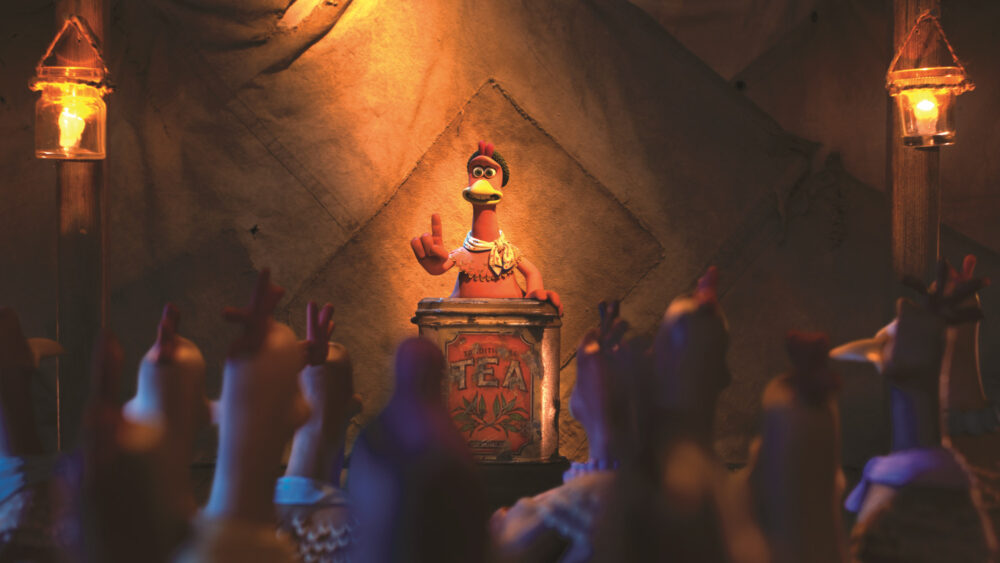
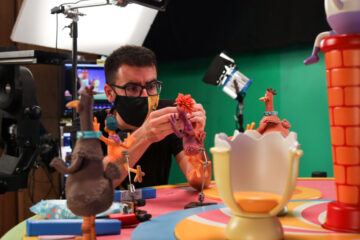
The Bible According to Aardman
Our first stop on the tour was the puppetry department — the perfect mix of craft, engineering and technical wizardry. While lifting one of the puppets, you could feel the heft of the mechanics and see many intricate details. “The rubber feathers are all of varied size,” said head of puppets Kate Anderson. “This randomization is applied before the 3D mold is printed, and it takes a week to paint all the plumage,” she explained. “Laika uses color 3D printers, which enables them to play with different materials, but we remain traditionally ‘Aardman’ with plasticine heads and beaks.” This is where the character details are captured and where the studio has mastered a fine balance between art and efficiency.
Next was the animation floor, a huge studio space set up like a village of curtained cubicles. We were introduced to Ian Whitlock, whose job was overseeing the team of animators to maintain a seamless continuity. “I worked on the first movie and had the original notes from Peter Lord as a reference, which helped put a ‘character bible’ together. This includes an expression sheet and walk cycles that work as a shorthand, especially for the director, Sam Fell, [to communicate] with myself and the animators.” Panning around Whitlock’s set piece, there was a box of various faces and mouths nearby. “Every tweak of a beak, every decision, is about focusing on the performances through simplification. We keep it punchy. That’s the Aardman style.”
‘Chicken Run was a giant step for us as a studio. To tell a feature-length story with our technique of stop-motion clay animation required us to move from our little cottage industry to this industrial scale.’
— Executive producer Nick Park
Animator Laura Tofarides — who trained at the Aardman Academy — took us through the stop-motion process in more detail. “We act everything out for Sam to look at in an edit. Once the right emotion is captured, I’ll test for half a day with shortcut movements.” She proceeded to move one of the mouths a fraction, then cranked a handle under the table that lends free body movement to the background characters. All the while, on her monitor, she had Dragonframe open: a stop-motion interface that lets her toggle between an overlay of the test run (as a guide) and the final animation. “After reading the character bible, we then had three months of preparation time before we were set loose. You’re animating for eight to nine hours a day, so you are learning and perfecting the craft constantly.”
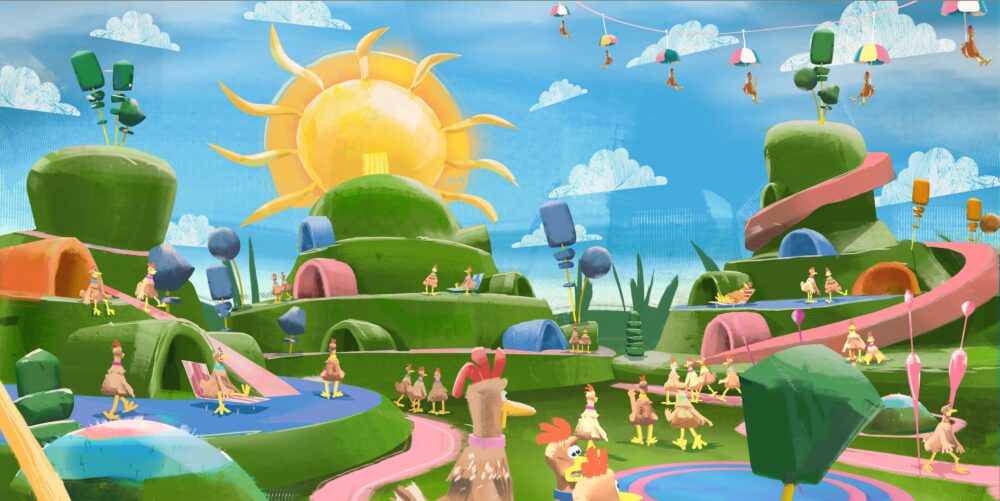
Foil and Fun-Land
Behind the next curtain, we saw director of photography Charles Copping crumpling foil around a cylinder. Low-tech and in-camera, it slowly turns and reflects the illusion of flames. The film’s “color script” that runs throughout the production becomes more and more noticeable, even right through to one of the final parts of the tour that placed supervising art director Matt Perry springing before us — “Ta-da!” — as he introduced us all to what appeared to be a stairway to heaven: a small portion of Fun-Land that resembles a utopian theme park which (inevitably) turns the chickens into nuggets.
By the time we visited, the original set was long gone; because the set was created at scale, it was unable to physically fit into the building and therefore filmed in sections and at various sizes. “We’re embracing new technology, such as virtual production, so we can have the digital background behind the sets in real time to help with composition.” Due to the various scales of each composited shot, Aardman had to find new ways of programming moves that matched the scale of another larger set piece. This “match moving” technique allowed for various CGI segments (within different planes of view) to be inserted into the live-action footage, which helped align with the correct positioning, scale, orientation and motion relative to the photographed objects in the shot. “It has taken everything the studio has learned over the past 50 years from the traditional to the high tech.”
Chicken Wrap
Director Sam Fell entered for lunch. Having worked on Flushed Away and Laika’s ParaNorman, he was onboard with the Chicken Run sequel from the onset, taking great pride in casting the right animators. “This is a big deal. It’s a legacy movie for Aardman,” Fell said.
He went on to highlight the phenomenal continuity at the heart of the studio’s work. “They have a strong foundation, so people can spend their whole lives making great work here. It’s wonderful, as everyone is completely invested in these characters. They know how they work, so there’s something about the souls of the chickens that is still in the hearts and minds of the crew.”
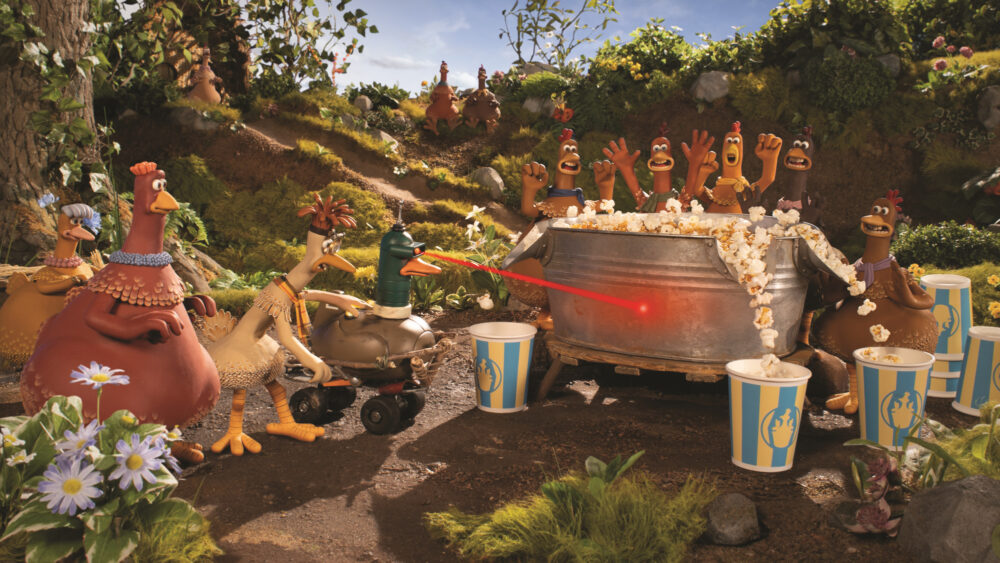
This foundation is more than evident during the visit, speaking to everyone from veterans to graduates of the Aardman Academy. They are a family in the truest sense of the word. “Dawn of the Nugget is a major milestone for the studio, and because Chicken Run was such a massive film for them, this is like handling the family silver. It’s incredibly important to the whole studio.”
Most of us were still eating our chicken wraps — (what?) — when Fell then picked up a pencil and began sketching, a demonstration of his mind being in several places at once. He touched upon his love of stop motion and what separates it from other forms of animation. “For me, it’s the direct involvement of the human hand and eye. You can walk around and see the progress on set; the ‘texture of things.’ You find some animators polishing out their thumbprints and I’m immediately: ‘Leave your thumbprints in there!’” He paused, pencil scratching on paper. “I’m quite impatient, so working on these films is a lesson on slow-mo. Every choice is crucial as it is magnified through animation. There are thousands of decisions to make from the color script to the shapes of things to rehearsing with the animators.”
‘I’m quite impatient, so working on these films is a lesson on slow-mo. Every choice is crucial as it is magnified through animation.’
— Director Sam Fell
Fell moved on to the story, which took two years to peck into shape. “An integral part of kick-starting the sequel was: ‘Do they continue hiding from the world or help others?’” he explained. “Of course, a lot has happened since the first film was made — they got the recipe right — Chicken Run brilliantly navigated a line between the dark drama of a story about chickens facing certain death, and comedy and lightness and fun. Plus, the craft was incredible. The way they executed it was, and still is, remarkable. In terms of story, sure, there were strong female characters, but as with those capitalist undertones of the first film, now there are the ecological elements. This is not only the next chapter of Ginger’s story, but, most importantly, this is truly a film of now.”
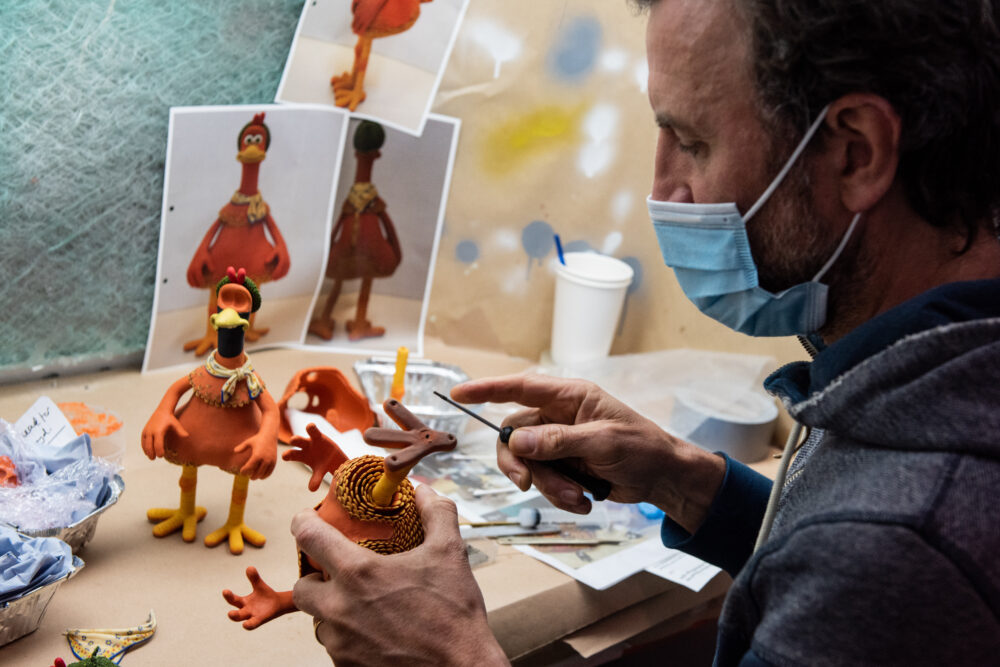
The audiences of the original movie in 2000 now likely have their own hatchlings and eagerly await this next adventure that sees Ginger (Thandiwe Newton) settled in a peaceful island sanctuary away from the dangers of the outside world. Now hitched to Rocky (Zachary Levi), they’ve hatched Molly (Bella Ramsey). But, with a new deadly threat to chicken-kind on the mainland, Ginger and her faithful team must risk the freedom they fought so hard for after their death-defying escape from Tweedy’s Farm. Not only has Mrs. Tweedy (Miranda Richardson) survived, but she’s also returned to her wicked ways: She has devised a new and terrible kind of fast food — the chicken nugget. “It’s her ultimate revenge on chickens to bring this devastation on them over the generations,” said Fell. “From a chicken’s point of view, the creation of the world’s first chicken nugget is an apocalyptic event.”
While the film plays with the utopian dream and dystopian nightmare, it manages to pay homage to everything from Dawn of the Planet of the Apes, The Truman Show, Gerry Anderson to Bond and Mission: Impossible-level action. Fun for everyone, indeed.
Aardman’s Chicken Run: Dawn of the Nugget will be released on Netflix on December 15.
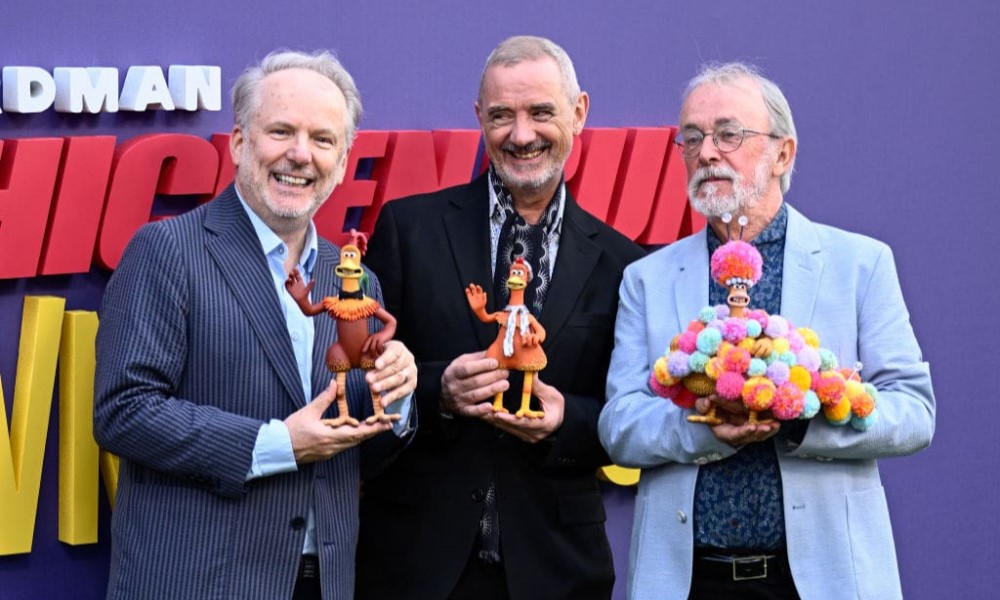
Chicken Bytes
- Nick Park made a small voice cameo in the original Chicken Run, performing the clucks Mr. Tweedy hears when he shines his torch on a teapot the chickens have disguised as a hen.
- Factoring in alternative scenes and changes, it took more than 100,000 storyboards for the production.
- The Aardman crew working on Dawn of the Nugget totaled around 350 people, while the production comprised 45 units at its peak.
- The film contains around 1,400 shots in total, of which only 28 are fully computer generated. The longest shot is the opening pan across Chicken Island, which is 784 frames, or 32.67 seconds. It took 80 working days to shoot the animation.
- More than 800 chicken wings were made for the production, while over 150,000 feathers had to be hand painted. Most puppets have a set of 14 mouths, but Molly had the largest mouth set at 24. With 16 Molly puppets made in total, there were 384 Molly mouths created for Dawn of the Nugget.
- To prevent the chicken puppets from having too much of a sheen on camera, each one had finely sifted icing sugar puffed onto its surface, creating an even, matte effect.
- Crushed walnut shells were used to create road surfaces in the film, while the soil texture on the chicken village set was made from recycled fallen leaves from a leylandii tree outside the studio.
- A total of 119 sets were built for the production, along with 130 animatable props, including a corn conveyor and a windmill.
- The popcorn silo sequence required 75 kilograms of popcorn kernels — equivalent to the weight of 25 real chickens.
- The numbers on the collars worn by some of the characters have special significance. The “Chosen Chicken” has “314,” as in 3.14 — the value of pi; Frizzle’s collar has “505,” which represents “SOS”; and Ginger’s collar has “983”: “9” for chronological storytelling and “83” representing International Women’s Day (March 8).
- If you look closely during the film’s final shot, you will spot a significant Easter egg: an imposter chicken in the form of the nefarious penguin Feathers McGraw, from the second Wallace & Gromit adventure, The Wrong Trousers.
Source: Aardman Animations




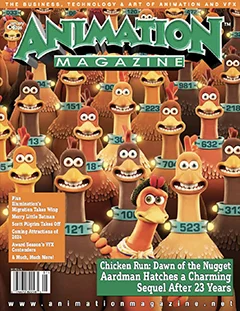


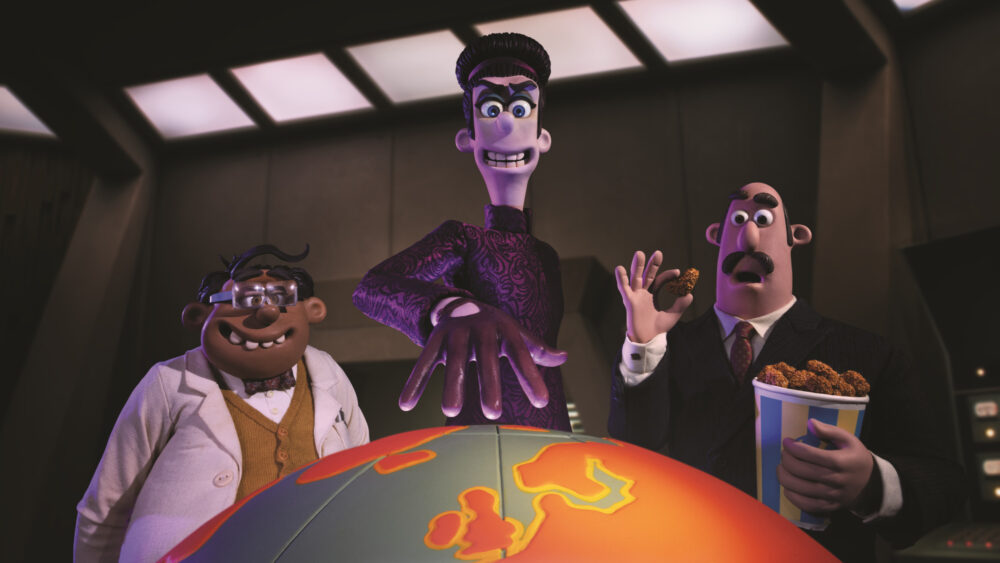
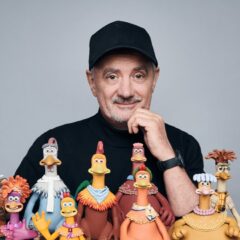

 Win a Funko X Lilo & Stitch Prize Pack!
Win a Funko X Lilo & Stitch Prize Pack! 
